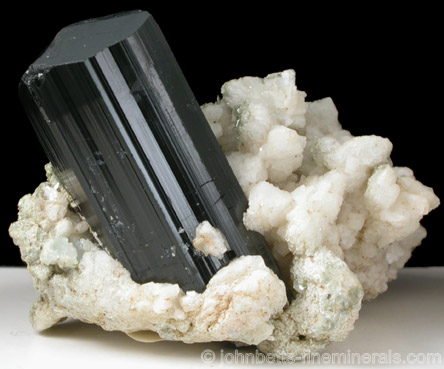The Mineral schorl

Schorl is best known as "Black Tourmaline". Although other forms of
Tourmaline may be black, Schorl is exclusively black and, unlike other
Tourmaline forms, is never transparent or even translucent. In a few rare instances, it may be intergrown together with Elbaite, with a specimen being part Schorl and part Elbaite.
Schorl is the most common form of Tourmaline. It may be highly lustrous and form in beautiful crystals, and is one of the most aesthetic black minerals known. It may form in tiny dense needles within a Quartz crystal where it is known as Tourmalinated Quartz.
Chemical Formula
NaFe2+3Al6(BO3)3Si6O18(OH)4
Crystal Habits
Usually as elongated prismatic crystals that are heavily
striated. Also as short, stubby, prismatic crystals. Many Schorl crystals have a rounded, triangular cross-section, and a flattened pyramidal termination. Seldom in
tabular crystals. Aggregates include columnar, radiating,
stalactitic, dense groups of acicular needles, and compact masses. Crystals may be curved or warped, and in
some cases may have their growth interrupted by host rock with the same
crystal appearing in two parts of a matrix. Crystal size can range from very small to excessively large crystals several feet in length.
Varieties
-
Rare form of Schorl where part of the hydroxyl is replaced with
fluorine. Fluor-schorlwas recognized as a distinct mineral
species by the IMA in 2011, with the following chemical formula:
NaFe2+3Al6(BO3)3Si6O18(OH)3F
Uses
Large and lustrous Schorl crystals are popular among collectors. The Schorl crystals in a white Albite or Microcline matrix have very nice contrast and make beautiful collector specimens. Schorl is occasionally used in jewelry as a black gemstone, and Tourmalinated Quartz composed of Schorl is sometimes polished or tumbled as a minor gemstone.
See the gemstone section on Tourmaline for more detailed information.
Noteworthy Localities
Outstanding Schorl crystals come from Pakistan in the Shigar Valley and Stak Nala, both in the Skardu District; and from several localities in the Gilgit District. Afghanistan produces fine crystals at Darra-i-Pech, Nangarhar Province. Some of the best Schorl crystals come from the Erongo region in Namibia, and excellent specimens from the Sahatany Valley, Antananarivo Province, Madagascar.
The famous gem pegmatites of Minas Gerais, Brazil have produced large and lustrous Schorl crystals, especially at
Golconda, in Governador Valadares; the Santa Rosa mine, Itambacuri; and the Cruzeiro and Pederneira Mines, São José da Safira. Radiating Schorl comes from Coronel Pringles, San Luis, Argentina.
European localities of Schorl include Sant'Ilario in Campo, Elba Island, Italy; Colico and Dorio, Lombardy, Italy; the Portugal 2 Quarry, Malpartida, Portugal; Dolní Bory, Moravia, Czech Republic; and Råneå, Norrbotten, Sweden.
In Canada, Schorl is found in Quadeville, Renfrew Co., Ontario. The well-known stalactitic variety sometimes known as Velvet Tourmaline comes from Santa Cruz, Sonora, Mexico.
In the U.S., the best Schorl comes from southern California and New England. California localities are the Pala District; the Warner Springs District; and the Little Three Mine in Ramona; all in San Diego Co. The Fano Mine, Cahuilla Mountain, in Riverside Co., is also a good producer. The best New England localities are Haddam and East Hampton, Middlesex Co., Connecticut; Groton, Grafton Co., New Hampshire; and Greenwood, Oxford Co., Maine.
Distingushing Similar Minerals
Elbaite - Even when black will never be fully opaque.
Dravite - Even when black has slightly brown hue on edges.
Aegirine - Different crystal form and steeper terminations.
Black Rutile - Has a reddish hue on edges, softer.